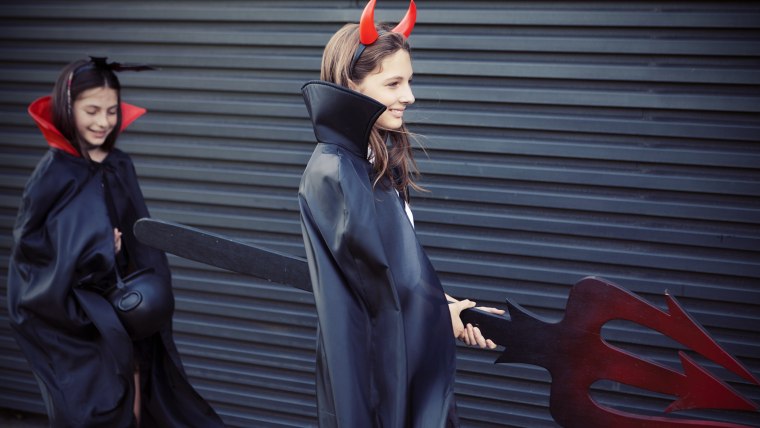Just when you thought ghosts and goblins were scary: Enter the tween and teen group Halloween costume.
While groups of besties deciding to dress up in a theme can be adorable, it can also raise problems of exclusion for kids — like when seemingly every girl in the fifth grade is dressed as a cheerleader except for two or three.
“It would probably be wonderfully fun if you’re one of the kids included in the group, but very much not so fun if you’re not the kid invited to participate in the group,” parenting author and mother of four Ann Douglas told TODAY Parents. “It’s like your low-ranking social status is put out there for everyone to see in such an obvious and visual way — it’s basically the pain of childhood exclusion on steroids.”
To avoid the issue, some schools have tried to get out in front of the problem by prohibiting group costumes altogether.

“Group costumes should not be worn at school as they promote exclusion of other students,” Shabonee Elementary School Principal John Panozzo in Northbrook, Illinois, wrote to parents earlier this month.
Braeside Elementary School Principal Joseph Hailpern wrote the following to parents in Highland Park, Illinois:
“[G]roup costumes at school and that evening typically mean great group fun paired with disappointment to the person left out (purposefully or not). I am sure you can imagine how hard it would be to show up to school dressed as something only to find your classmates organized around a theme. Inclusion or individuality are easy choices to make. Please take a moment to think about the other children in class who you may not be aware of — who spend hours each day stressing out about being included.”
Never miss a parenting story with the TODAY Parenting newsletter! Sign up here.
Hailpern has seen this sort of hurt play out before. “Nearly every year, November first is the day we see kids return to school after a night that was meant to be utter fun, only to see the sadness of realizing that they’ve been left out of a group costume,” he told TODAY Parents. “Being left out does not mean that it was purposeful or malicious. Rather, groups of friends who typically spend time together decided to plan something and incidentally left someone out. Parents do this to, usually unbeknownst to them. [My] 'beware' post was to prompt thinking of who may or may not be included, both with purpose and without.”
Though principals don't have a number on what constitutes a “group” in mind, if it's enough kids to make someone feel left out, it's too many.
“A group is any number of people that extends beyond normal context, “Hailpern said, adding that family members dressing as a group are exempt from the worry of leaving people out. In contrast, he said, groups of friends “can form a critical mass quickly and there’s no firm line for this. Three kids dressing together can easily leave one out. All the boys in a grade deciding to dress as something with a girl who wants in, but wasn’t invited, can be exclusive. No firm lines on numbers, but thinking about context is what matters.”
Millburn, New Jersey’s Washington School Principal Peter Mercurio, who also emailed parents a caution against group costumes in school, said that what matters is how students feel. “It’s hard to quantify [what constitutes a group],” Mercurio told TODAY Parents. “The message is more about being inclusive and to be aware of others’ feelings.”
Parenting experts say that group Halloween costumes can easily put toxic social group dynamics into high relief, especially for those children who are excluded from the “pack.”
So what to do, as a parent?
Lauren Paul and Molly Thompson, cofounders of the Kind Campaign to stop emotional violence among girls, suggest checking in with children before Halloween even begins, in order to determine what motivates them to wear their specific costume selections — and to encourage creativity above conformity.
Open, proactive communication, said Douglas, can head problems off at the pass.
“Parents should talk with their kids ahead of time, and make their expectations of their kids clear,” Douglas said, adding that if a child is set on a group costume, parents can help their child figure out ways to do it that include, not exclude.
Perhaps most importantly, parents should understand that while group Halloween costumes highlight problematic group dynamics, they don’t necessarily create the underlying problem.
“Ultimately, school cliques and leaving others out is not a phenomenon unique to Halloween — this type of behavior exists all year round," said Thompson. "And while it may be elevated around this holiday, the larger issue as a whole is something that we need to work to put an end to on an everyday basis, not just shed light on at Halloween.”
If your kid is on the left-out end of the group costume, "remind your child that school is just one chapter of their story,” Paul said. “When we go through those things when we are younger, something like feeling left out of a group costume can feel all-consuming. It’s so important to remind them that they will get through this experience, and they are not alone in what they are feeling.”